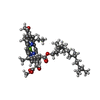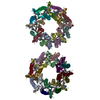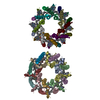+Search query
-Structure paper
| Title | Elucidating interprotein energy transfer dynamics within the antenna network from purple bacteria. |
|---|---|
| Journal, issue, pages | Proc Natl Acad Sci U S A, Vol. 120, Issue 28, Page e2220477120, Year 2023 |
| Publish date | Jul 11, 2023 |
 Authors Authors | Dihao Wang / Olivia C Fiebig / Dvir Harris / Hila Toporik / Yi Ji / Chern Chuang / Muath Nairat / Ashley L Tong / John I Ogren / Stephanie M Hart / Jianshu Cao / James N Sturgis / Yuval Mazor / Gabriela S Schlau-Cohen /   |
| PubMed Abstract | In photosynthesis, absorbed light energy transfers through a network of antenna proteins with near-unity quantum efficiency to reach the reaction center, which initiates the downstream biochemical ...In photosynthesis, absorbed light energy transfers through a network of antenna proteins with near-unity quantum efficiency to reach the reaction center, which initiates the downstream biochemical reactions. While the energy transfer dynamics within individual antenna proteins have been extensively studied over the past decades, the dynamics between the proteins are poorly understood due to the heterogeneous organization of the network. Previously reported timescales averaged over such heterogeneity, obscuring individual interprotein energy transfer steps. Here, we isolated and interrogated interprotein energy transfer by embedding two variants of the primary antenna protein from purple bacteria, light-harvesting complex 2 (LH2), together into a near-native membrane disc, known as a nanodisc. We integrated ultrafast transient absorption spectroscopy, quantum dynamics simulations, and cryogenic electron microscopy to determine interprotein energy transfer timescales. By varying the diameter of the nanodiscs, we replicated a range of distances between the proteins. The closest distance possible between neighboring LH2, which is the most common in native membranes, is 25 Å and resulted in a timescale of 5.7 ps. Larger distances of 28 to 31 Å resulted in timescales of 10 to 14 ps. Corresponding simulations showed that the fast energy transfer steps between closely spaced LH2 increase transport distances by ∼15%. Overall, our results introduce a framework for well-controlled studies of interprotein energy transfer dynamics and suggest that protein pairs serve as the primary pathway for the efficient transport of solar energy. |
 External links External links |  Proc Natl Acad Sci U S A / Proc Natl Acad Sci U S A /  PubMed:37399405 / PubMed:37399405 /  PubMed Central PubMed Central |
| Methods | EM (single particle) |
| Resolution | 6.4 - 11.4 Å |
| Structure data | EMDB-26134, PDB-7tuw: EMDB-26138, PDB-7tv3: EMDB-28962: LH2-LH3 antenna in antiparallel configuration embedded in a nanodisc EMDB-28963, PDB-8fbb: |
| Chemicals |  ChemComp-BCL:  ChemComp-LYC: |
| Source |
|
 Keywords Keywords | PHOTOSYNTHESIS / antenna / membrane protein / nanodisc / bacteriochlorophyll |
 Movie
Movie Controller
Controller Structure viewers
Structure viewers About Yorodumi Papers
About Yorodumi Papers











 magnetospirillum molischianum (magnetotactic)
magnetospirillum molischianum (magnetotactic)